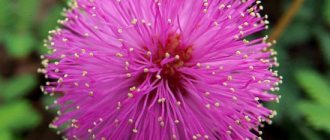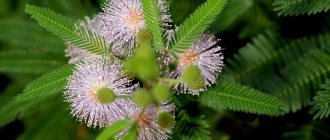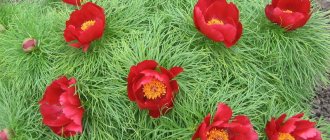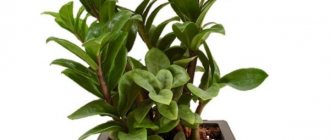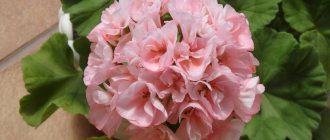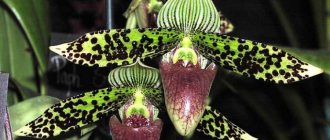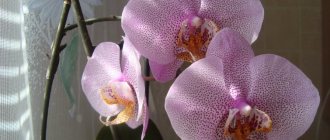Today the topic of our story is the bashful mimosa. The first thing that attracts attention is the name of the plant. Why did mimosa suddenly become shy? What confuses her and why is she shy? I propose to learn about the origin of this “modest” flower, its sowing technology and cultivation options. After all, mimosa can be planted both in the garden and in the room on the windowsill. But everything has its own nuances. You will learn about them in this video.
Mimosa bashful: growing correctly
Mimosa pudica - what kind of flower is it?
A delicate flower brought to Europe from the tropical regions of Latin America is a perennial herbaceous plant from the genus Mimosa of the Legume family. The impossibility of growing mimosa shyus in the natural conditions of mid-latitudes has made it a popular flower for the home or greenhouse.
What does a bashful mimosa look like?
When kept at home, the blooming prude grows no more than 50-60 cm in height. In nature, this subshrub grows 2-2.5 times taller. The straight trunk with small thorns makes it look like a miniature tree. All parts of the plant are covered with a delicate hairy outer layer.
The long cuttings of the branches are decorated with groups of small bipinnate sensitive leaves, because of which the plant actually received the name Mimosa pudica. Sensitive foliage reacts to light, darkness, air movement and the slightest touch. Small pink-purple spherical flowers eventually turn into pods, each of which contains 8-10 seeds.
Shy impatiens folds its leaves from the wind, light and hand touch
For your information! A tender plant tends to smell and drop its leaves not only because of external irritants. An exotic flower, obeying the biological cycle, does this every 22 hours.
Due to the peculiarities of its care, the plant is considered capricious. Neglecting maintenance rules can lead to the death of the plant in the cold season. And then, to make up for the loss, gardeners have to grow a new plant from seeds.
Growing mimosa pudica from seeds at home
Despite the fact that mimosa, called impatiens, is a perennial plant, at home it is most often grown as an annual. This is due to the fact that some novice flower lovers cannot provide proper care and satisfactory conditions.
Mimosa Hostilis - what kind of plant?
For mimosa shy, the following can be detrimental:
- low temperature;
- presence of drafts;
- lack of sunlight or artificial lighting;
- excess moisture in the soil;
- low air humidity, heat.
Important! In addition to these factors, the healthy development of a plant can be affected by: tobacco smoke, disease or insect pests.
Planting mimosa
Recommendations for planting plant seeds:
- To plant seeds, use small containers with a diameter of 9 cm.
- They are filled with a substrate of equal parts of leaf soil, humus, turf soil and a little sand - half of one part.
- It is advisable to disinfect the substrate. Spill the soil with a solution of potassium permanganate.
- Place drainage at the bottom of the container.
- Seeds are usually not buried, but pressed onto the substrate.
- The container is covered with film and placed in a warm room.
It is necessary to monitor the appearance of sprouts under the film. As soon as they appear, it is advisable to ventilate the container, that is, open it for about half an hour. The measure will prevent the appearance of blackleg, which loves young shoots so much.
Seeds germinate in about 7-8 days.
Mimosa has a high germination rate. It is rare that seed does not produce results. This usually happens when seeds are stored improperly. When the sprout develops two full-fledged leaves, it can be transplanted into a permanent pot with the same composition of the substrate. Only the components should already be in equal proportions. The sprouts are gradually accustomed to sunlight. They are exposed to open rays for a certain period of time and again put away in a shaded place. Make sure that the leaves do not get burned. Mimosa grows quite quickly, it needs to create all the conditions for this, in particular, proper care.
How to care for impatiens at home
Mimosa - what kind of flower is it, what does it look like
Caring for mimosa pudica at home will not require much effort if the requirements for temperature and light conditions are met. In addition, the plant reacts sensitively to watering, spraying and fertilizing with mineral fertilizers.
Indoor Mimosa Pudica reacts painfully to everything
Note! Lack of sufficient experience and skills in growing exotic plants can lead indoor mimosa to loss of decorativeness, disease or complete death. A positive result is possible only if the rules of agricultural technology are observed.
Illumination and temperature conditions
In order for the plant to feel comfortable, bloom long and profusely, it needs good lighting. It is best to place the flowerpot on the windowsills on the south side of the house.
In winter, in the absence of sufficient light, the shy mimosa will require additional lighting. Artificial lighting should provide the plant with at least 10-12 hours of daylight.
Important! Insufficient lighting negatively affects the decorative appearance of the plant: it stretches out or even loses its foliage. Despite the fact that the sissy loves an abundance of sunlight, in the summer heat it should be slightly shaded, otherwise direct sunlight can cause burns. This is especially true for weak plants or young seedlings grown from seeds.
Artificial lighting mimosa
In addition, growing a tropical plant requires strict adherence to temperature conditions. The ideal air temperature for normal seedling growth ranges from 20-24 °C.
In the cold season, when the plant is dormant, the optimal ambient temperature should be between 16-18 °C. Changes or sharp drops in temperature will negatively affect the health of indoor flowers.
Note! Seedlings that require a tropical climate react negatively to heat and dry air. Therefore, it is extremely undesirable to place mimosa in a flower pot near heating radiators or heating devices.
Failure to comply with temperature and light conditions in winter leads to the fact that in the spring the exotic flower will look unattractive. The stems, weakened by lack of light and heat, will become too elongated and their color will become pale green.
Watering rules and humidity
Accustomed to tropical humidity, pink mimosa at home requires abundant watering. This is especially true during the hot season. In the summer heat, when the air temperature exceeds 24-26 °C, it is necessary to periodically spray the seedling. Lack of moisture and low humidity can affect the beauty of the plant: its foliage will turn yellow or begin to fall off rapidly.
For your information! In climatic conditions where day and night air temperatures are not subject to sudden changes, the flower can be placed in the summer on a balcony or in the courtyard of a private house. The main conditions for such a temporary “relocation” are timely watering and periodic spraying.
In winter, the plant does not require frequent watering, as it is at rest. A decrease in air temperature and excess moisture in the soil can cause irreparable harm. The root system will begin to rot, and the seedling will eventually disappear.
Fertilizing and soil quality
In order for the bashful plant to acquire the necessary decorative effect, it requires fertile soil, which can be purchased at a specialized store. It is also possible to prepare the soil yourself. To do this, just mix in equal proportions:
- peat;
- chopped tree bark;
- washed quartz sand;
- perlite
In addition to the fact that the bottom of the flower pot must have a hole, it must be lined with a small layer of charcoal or expanded clay. This will ensure good drainage and protect the root system from excess moisture, which causes rot and fungal diseases.
Important! Garden soil should never be added to the soil mixture. The tropical plant requires loose soil, and soil from the garden plot can compact it.
To maintain the soil in an ideal condition for impatiens, it is necessary to systematically apply organic and mineral fertilizers during the growing season and active growth. The frequency of fertilizing should be at least 2 times a month using the dosage indicated on the drug.
Healthy flowering plant after fertilizing
The optimal period for fertilizing is from early spring to mid-autumn. After the plant has flowered and entered a dormant state, the use of fertilizers should be stopped.
Flower container size
For normal vegetation and crown development, mimosa does not need a large flowerpot. This is due to the fact that the plant does not have a very developed root system. Planting in a larger container is carried out only in the case of planting young seedlings in a permanent place.
Pruning and replanting
Deviations from the rules of agricultural technology and unsatisfactory living conditions can lead to the capricious sissy quickly losing its decorative appearance:
- the foliage will turn pale green;
- the trunk will stretch out greatly;
- leaves turn yellow or fall off;
- the plant will not bloom or stop blooming.
To remedy this situation, flower lovers use intensive pruning or pinching. In this way a beautiful crown is formed.
In exceptional cases, when the plant has overwintered satisfactorily, it can be transplanted into another container. This process is carried out exclusively by transshipment, so as not to damage the roots. To do this, the earthen lump in the flower pot must be slightly dried so that it does not fall apart during the replanting process.
Rules of care
Caring for mimosa is complicated by the fact that the plant requires conditions close to a tropical microclimate.
- Lighting. With mimosa they work according to the principle - the more light, the better. Prefers plenty of light and sun. There is no need to shade - despite their tenderness, the leaves do not get sunburned. With a lack of light, it quickly stretches out and loses its decorative effect. It is recommended to avoid drafts, tobacco smoke, and fumes when cooking - frequent curling of leaves depletes the plant.
- Temperature. From early spring to late autumn it prefers a stable temperature of 20-24°C. When grown as a perennial, keep it at 16-18°C in winter.
- Humidity. Maintain at 70%. Dry air is detrimental to a flower. High humidity levels are achieved using special air humidifiers and frequent spraying. A pot with a flower is placed on a tray with wet pebbles or bowls of water are placed next to it. In winter, a wet cloth is hung on the radiators, wetting it as it dries.
- Watering. To understand whether mimosa needs water, touch the top layer of soil. If it dries out, it indicates the need for watering. On average, at a temperature of 20-24°C, water at intervals of 2 days. Morning watering with soft water is recommended.
- The soil. The main requirement is loose, well-drained, breathable soil. A simple and successful option is a mixture of sand, turf and peat. Expanded clay or large pebbles are used as drainage.
- Feeding. Every 15 days during the growing season. Use any mineral complexes for flowering potted crops. The concentration is halved.
- Transfer. The flower is most often grown as an annual crop. Transplantation is performed in rare cases. For example, if a pot was initially used that was too small. When transplanting, they try not to disturb the integrity of the earthen coma.
Advice! Mimosa pudica seeds can be obtained from your plant. It is easily pollinated by transferring pollen from one flower to another with a brush or by gently touching the flowers to each other. After successful pollination, a pod will form with flattened black peas—the seeds of the plant. Store the seeds in a paper bag on the refrigerator door.
Features of plant flowering
Gardenia in bloom - what an indoor and outdoor plant looks like
Growing indoor mimosa is not as difficult as achieving abundant flowering. The plant reacts sensitively to the slightest conditions of maintenance and care. Therefore, it requires attention and care not only during the formation of flower buds, but throughout the year.
Period of activity and rest
The active phase of plant development and growth is limited to the period between mid-spring and late autumn. During this period, the bashful beauty requires abundant watering, spraying and systematic feeding with fertilizers.
During the dormant period, the plant should be watered only when the top layer of soil in the pot dries. Low room humidity can be compensated with a cup of water placed next to the flower pot. Any kind of fertilizing in winter is categorically excluded.
Types and shape of flowers
Botanists have studied and described more than 600 species of mimosa. The most common in the European part of the continent are 3 types:
- bashful mimosa. Its pink-lilac flowers are collected in the shape of a ball and consist of four parts;
- rough (lat. Mimosa Scabrella). The flowers are collected in lush panicles of bright yellow color;
- lazy (lat. Mimosa Pigra). The spherical inflorescences are white.
Blooming Mimosa Scabrella
Most species known to science are perennial shrubs and are widely used for decorative planting.
When and what to feed mimosa?
Touch-me-not, like any plant, needs nutrients. She receives them during feeding. It is carried out when the bush is actively growing. In spring and until mid-summer, indoor mimosa bashful is fed with nitrogen, potassium and phosphorus. These fertilizers are mixed in equal proportions and applied to the soil twice a month. In the second half of summer and until the beginning of autumn, buds form. Therefore, phosphorus and potassium are needed in large quantities. To make the soil more nutritious, bone meal should be added to it. You can fertilize with complex mixtures for home flowers. In autumn, shoot growth stops. At this time, the application of any fertilizers stops. If this is not done, the mimosa pudica will not rest and may weaken. Growing a houseplant will not bring pleasure, as the bush will lose its decorative effect.
Flower propagation methods
The high demands on light, heat and moisture mean that not every exotic lover will agree to care for such a fastidious exotic all year round. It is much easier to grow a new seedling with the onset of spring. That is why mimosa pudica is most often used indoors as an annual plant.
Reproduction by cuttings
Trying to decorate their home with an exotic sissy, some gardeners are attempting to propagate it by cuttings. To do this, a cutting of a branch at least 20 cm long must be kept for 2-3 hours in a solution of root or potassium humate.
The cuttings prepared in this way are planted in moist, loose soil.
Note! Planting material can be covered with a large plastic cup or glass jar. The microclimate formed under the hood will give a greater chance that the first roots will appear in 2 weeks.
Propagation by seeds
In order for an unusual flower to settle forever in the collection of house plants, avid flower growers try to plant it with seeds every spring. This method of reproduction is considered the most effective because it gives good results.
Young shoots from seeds
It is enough to plant a seed in a moistened substance in early or mid-March and cover it with a small layer of soil. The planting container should be covered with polyethylene or a piece of glass, placing it in a warm place. In 2-3 weeks the first shoots will appear.
Planting seeds for seedlings
Before planting, prepare a container for planting. You can take plastic or wooden containers. Cups, pots, and peat tablets are also suitable.
If you choose a tray, pot or cup, be sure to make drainage holes at the bottom of the container. Water should not stagnate inside the container. Otherwise, the roots will rot and young plants will die. Now you need to think about the soil for sowing.
The easiest option is to take a ready-made universal primer. To make it looser and lighter, you can add soil improvers - zeolite, perlite, vermiculite or sand. Then the substrate must be thoroughly mixed.
Then proceed like this:
- Fill the container with universal soil.
- Lightly compact the soil. Water it generously with water at room temperature.
- If desired, you can pre-soak the seeds in a weak solution of potassium permanganate. But this measure is not mandatory.
- Spread the seeds on the surface of the soil. Keep a distance between them of about 2-3 cm.
- Sprinkle a thin layer of soil on top - no more than 5-10 mm.
- Moisten the plantings with a spray bottle.
- Cover the container with film, glass or a transparent lid to create a “greenhouse” effect.
Prepare a container for sowing mimosa pudica
Spread the seeds on the surface of the soil
Moisten the plantings and create a “greenhouse” effect.
Place the trays with the crops in a bright place with bright and diffused light. The ideal option is to place containers under phytolamps. Light is very important for mimosa. If it is deficient, the stems of the plant will begin to stretch, which will negatively affect the decorative appearance of the bush. The air temperature before emergence should be quite high - about +25°C. From time to time, open the “greenhouse” for ventilation. Moisten the soil by spraying from a spray bottle.
The first shoots will appear 1-2 weeks after planting. If the seeds were planted in a common container, they will need picking and replanting in separate cups. The procedure should be carried out only when the seedlings have grown to 5 cm. Plant 2-3 sprouts in 1 glass.
Growing problems, diseases and pests
Mimosa, accustomed to a tropical climate, requires special conditions and careful care. The key threat that prevents indoor pets from growing and enjoying a healthy appearance is harmful insects. These small, sometimes barely noticeable pests can cause irreparable damage to a home flower.
How to deal with them
Damage to indoor plants by harmful insects most often occurs due to improper care of them. Usually they are started in cases of violation of thermal, light and water regimes. Lack of light and overly wet soil are an excellent environment for their reproduction.
Insecticides such as phytosporin or actara are used to control pests. The same means can be used as a preventive measure if pests appeared earlier on a plant adjacent to the mimosa. To prevent this nuisance, you should periodically inspect the crown of your home flowers.
Aphids are a serious pest of indoor plants.
Beautiful and capricious impatiens, requiring special attention, can decorate any home, office or greenhouse. To do this, you should carefully follow the step-by-step recommendations of specialists. The gratitude of a well-groomed plant will be expressed in an attractive appearance and abundant flowering.
Facts to Note About the Mimosa Plant
In many countries around the world, the arrival of spring is associated with mimosa, and lush celebrations are held dedicated to this delicate plant with bright sun-like flowers.
Such festivals are held, including in France and Montenegro. Mimosa has the ability to respond to any mechanical stress to which its parts are exposed. At the slightest touch, the plant folds its leaves and lowers its branches. However, after 20–30 minutes, the appearance of the mimosa becomes original. Mimosa has the same reaction to the change of day; at night, the leaves of the plant are folded, but with the first rays of the sun they take on a “working state”. However, if you often experiment with the delicate silver acacia, irritating its hairs, it will quickly become depleted. Dried root of Mimosa tenuiflora contains about 1% dimethyltryptamine, which is referred to as DMT, and the bark contains up to 0.03% of this substance. It was the bark of the people living in the northeast of Brazil that was traditionally used as the main psychoactive decoction, which was called “jurema”.
The variety of mimosa pudica is poisonous and causes poisoning of livestock if it grows in pasture areas. Also, due to the allergens that pollen produces, you should not give mimosa or give it to people with allergies.
